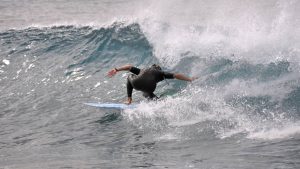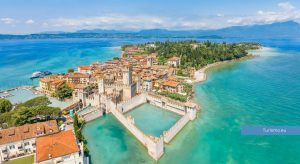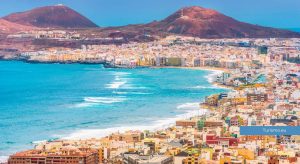Gran Canaria, one of the main islands in the Canary archipelago, is often called a “miniature continent” due to its astonishing variety of landscapes, climates, and environments. Golden beaches, historic villages, dramatic mountains, and nature reserves coexist in perfect harmony.
If you’re planning a trip to Gran Canaria, here’s what you absolutely shouldn’t miss.
What to See in Gran Canaria
Las Palmas de Gran Canaria: where history meets the sea
The capital, Las Palmas, is a vibrant mix of culture and beach life.
Lose yourself in the maze of cobbled streets in Vegueta, the oldest quarter, where colonial buildings with wooden balconies frame lively squares. Here, you’ll find Santa Ana Cathedral, with its imposing Neo-Gothic façade and a panoramic mirador atop its towers. Just steps away, the Casa de Colón Museum explores the island’s ties to the Americas through fascinating artifacts and flower-filled courtyards.
Nearby, Playa de Las Canteras ranks among Europe’s best urban beaches—a 3 km stretch of golden sand sheltered by a natural reef, perfect for swimming among tropical fish or catching waves. At sunset, the seafront promenade comes alive with tapas bars and cocktail spots.
Maspalomas Dunes: where the desert meets the ocean
In the south, the Maspalomas Dunes are a surreal sight: 400 hectares of wind-sculpted fine sand, evoking the Sahara. A sunset stroll here reveals mesmerizing light plays. The nature reserve also includes a palm-fringed oasis and a lagoon (La Charca). Nearby stands the Maspalomas Lighthouse, operational since 1890 and an iconic landmark.
Just steps away, Playa de Maspalomas is ideal for sunbathing, while neighboring Playa del Inglés buzzes with nightlife and seaside dining.
Puerto de Mogán: The “Little Venice” of Gran Canaria
This picturesque fishing village, known as “Little Venice,” charms with its canals, whitewashed houses draped in colorful blooms, and a laid-back vibe. Stroll its lanes, enjoy a waterfront meal, or take a boat trip.
The Inland: mountains and timeless villages
Venture beyond the coast to discover Gran Canaria’s green heart. The Nublo Rural Park is a hiker’s paradise, dominated by the Roque Nublo, an 80-meter volcanic monolith. The trail to its summit (about 1 hour) rewards with breathtaking valley views. Nearby, Roque Bentayga, sacred to the island’s indigenous people, hides ancient rock carvings and an interpretive center.
Nestled in the central highlands, La Presa de Las Niñas is a dam with a serene artificial lake surrounded by pine forests—ideal for picnics, quiet relaxation, or hiking through unspoiled landscapes. It’s also one of the few areas on the island with designated free camping spots, popular with locals on weekends.
Don’t miss Teror, a postcard-perfect village with pastel houses and ornate wooden balconies. The Basilica of Our Lady of the Pine (the island’s patron saint) is a Baroque gem. On Sundays, the local market sells artisan cheeses and almond sweets.
Another must-visit is Tejeda, ranked among Spain’s prettiest villages, nestled in lush greenery and famous for its almond-based desserts.
Barranco de Guayadeque
This lush, dramatic ravine is dotted with caves once inhabited by the pre-Hispanic Guanches—some now house restaurants or homes. A visit here unveils the Canary Islands’ indigenous history amid raw natural beauty.
The West Coast: cliffs and natural pools
Head to Agaete, a fishing village where you can sample rare locally grown coffee. The Las Salinas Natural Pools, carved into lava rock, invite a refreshing dip. From here, access Tamadaba Natural Park, a mountainous reserve with dense pine forests and sweeping ocean views.
North and East: hidden beaches and aboriginal heritage
On the north coast, Playa de Güi Güi is a secluded beach reachable only by hike or boat—perfect for solitude seekers. Near Gáldar, the Cueva Pintada Museum and Archaeological Park reveals the island’s ancient past through caves adorned with geometric designs.
Museums and Culture
Beyond nature, Gran Canaria boasts cultural gems like the Museo Canario (Canary Museum), CAAM (Atlantic Center of Modern Art), and Elder Museum of Science. Traditional events, such as the Las Palmas Carnival, are vibrant highlights.
Did You Know?
- Gran Canaria is nicknamed the “miniature continent” for its microclimates—you can go from sunny beaches to misty pine forests in just a short drive.
- The Fiesta del Charco in Agaete revives an ancient Guanche tradition, where participants catch fish barehanded in a lagoon.
Unique Experiences
- Canarian Cuisine: Try gofio, papas arrugadas (wrinkled potatoes) with mojo sauce, Agaete cheese, and local wines.
- Local Markets: Visit Teror’s Sunday market or Arguineguín’s for crafts and regional flavors.
- Stargazing: With clear skies and high altitude, Tejeda is prime for astronomy tourism.
Practical Tips
- Pack a light jacket—mountain evenings can be cool.
- Drive cautiously on winding inland roads.
- Book popular restaurants in advance, especially in peak season (June–September).
When to Go
Gran Canaria enjoys spring-like weather year-round (20–28°C / 68–82°F). Winter (November–February) is quieter, while summer attracts beachgoers. For fewer crowds but sunshine, visit April–May (windier) or September–October.
Getting Around
Buses (guaguas) connect major towns, but renting a car is best for flexibility. Roads are well-maintained, and you can drive from coast to mountains in under an hour. Taxis are affordable, especially when shared.





